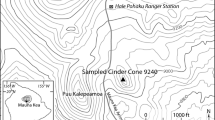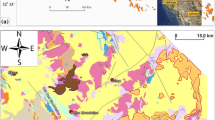Abstract
Olivine, low-Ca pyroxene, diopside, and spinel from a suite of protogranular lherzolite xenoliths from southeastern Australia have been analysed for their major and trace element compositions using electron microprobe and laser ablation ICPMS. Bulk compositions of the lherzolites range from fertile (12–13% modal diopside) to depleted (2–3% modal diopside), with equilibration temperatures of 850–900 °C indicating entrainment of these lherzolites from relatively shallow depths (probably ≤ 35 km) within the lithosphere. Mineral compositions and abundances indicate a primary control by partial melting, with decreasing abundance of modal diopside accompanied by increasing Mg# of olivine and pyroxene, decreasing Al and Ti contents of diopside, increasing Ni contents of olivine, and increasing Cr/Al of spinel. HREE, Y, and Ga in diopside also follow melting trends, decreasing in concentration with increasing Mg#. In contrast, highly incompatible elements such as LREE, Nb, and Th reveal divergent behaviour that cannot be ascribed entirely to partial melting. Diopsides from the fertile lherzolites have mantle-normalized patterns that are depleted in Th, Nb, and the LREE relative to Y and the HREE, whereas, diopsides from the cpx-poor samples are strongly enriched in Th, Nb and the LREE, and have elevated Sm/Hf and Zr/Hf, and low Ti/Nb. All diopsides have strongly negative Nb anomalies relative to Th and the LREE. Trace element patterns of diopside in the fertile lherzolites can be reproduced by ≤ 5% batch melting of a primitive source. The negative Nb anomalies are a consequence of this melting, and do not require special conditions or tectonic environments. The low concentrations of Y and HREE in diopside from the cpx-poor lherzolites cannot be produced by realistic degrees of batch melting, but can be accomplished by up to ∼20% fractional melting, suggesting multiple episodes of melt depletion. Os isotopic compositions of these lherzolites show that the melt depletion events occurred in the middle and late Proterozoic, demonstrating the long-term stability of lithospheric mantle beneath regions of eastern Australia. The LREE-enriched diopsides are well equilibrated and record metasomatic enrichment events that pre-date the magmatism that entrained these xenoliths. Trace element patterns of these pyroxenes suggest a carbonatitic melt as the metasomatic agent.
Similar content being viewed by others
Author information
Authors and Affiliations
Additional information
Received: 24 September 1996 / Accepted: 12 August 1997
Rights and permissions
About this article
Cite this article
Norman, M. Melting and metasomatism in the continental lithosphere: laser ablation ICPMS analysis of minerals in spinel lherzolites from eastern Australia. Contrib Mineral Petrol 130, 240–255 (1998). https://doi.org/10.1007/s004100050363
Issue Date:
DOI: https://doi.org/10.1007/s004100050363




